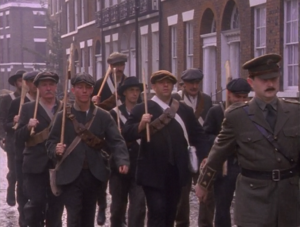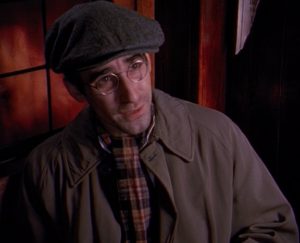Young Indiana Jones’ episode titled “Ireland 1916” portrays Ireland in the midst of a fragile time. Members of the Irish Citizens’ Army march around the streets with props heisted on their shoulders, imitating guns.

Yet Maggie Lemass, Jones’ love interest for this episode, states that “Nobody takes any notice. They’re silly fellas, a joke, but don’t tell Sean I said so.” Sean is her brother – a Fenian himself. For him, and surely for those marching down the street, this cause for freedom is real, and not some silly joke. These men are obviously a haphazard army. Their clothing, though attempting to be somewhat cohesive, is mismatched. They range in age from young to old, and their marching is not quite in unison. Yet to them, this cause means everything. Sean himself did quite a lot for Ireland in his time.
Young Indiana Jones was created to act “…as an innovative step in educational television,” (cite website). As a show that takes up less than an hour, it does the job that it can in potentially teaching students about the 1916 Rising. Many Dubliners, like Maggie Lemass in the show, did not take the Fenians seriously. Even when the Fenians took over the General Post Office, many saw them as nothing but a nuisance. Young Indiana Jones emphasizes this in Pearse’s reading of the Proclamation. When Jones asks an elderly woman what is going on, she states, “Some kind of foolishness,” and a man attempts to go straight into the post office immediately after seeing Fenians with guns in their hands guarding the door.

The show does portray the chaos and the bloodiness of the Rising quite well. While the Fenians are portrayed as fighting from anywhere they can get to, the soldiers are seen attempting to keep up their lines and using brute force (cannons and the like) to break through the Fenian forces. However, Young Indiana Jones makes the rising out to be quite a bit shorter than it was (a single day as compared to almost a week), but one can only assume that this was due to the time constraint of the show being under an hour long. Yet this leaves one to think – why did they spend so much time on Jones’ relationship with others rather than on the actual Rising? Perhaps it was to keep the show more interesting for student viewers with a love interest, jealous brother, and a passionate playwright taking up the spotlight with a passionate young Indiana Jones, and with the historical information in the background.
In the midst of the time leading up to the full scale rising, we meet Sean O’Casey – a young and serious, yet passionate playwright. Rejected by Yeats, he wants “to write plays that stink of life, real life. I wanna rub people’s noses in it so maybe they’ll get up and do something about it.” He is especially angered when Jones goes to the theater to see a musical, and ends up humming “When Irish Eyes are Happy.” He states that it is a mockery of Irish culture, making them all seem “like a laughingstock.”
However, when it comes to the Irish Citizens’ Army and Fenians, he is not optimistic. When Maggie’s brother, Sean, comes to relay a message from the Fenians to him, he angrily states, “If it’s about the Citizen Army, you can tell the boys down at Liberty Hall that I’ve resigned.” Thus, as an educational tool, the series gets O’Casey’s ‘official’ opinion on the rising quite right (as shown here).

In terms of the actor chosen to play O’Casey, John Lynch was the choice of the studio. According to Fandango, he was born in Northern Ireland in 1961. One of his first professional roles was as an IRA recruit, Cal, “who falls in love with the widow of a man he has killed.” IRA members were notoriously violent protesters against the English monarchy. It is interesting, then, that Lynch plays a character in Young Indiana Jones who disagrees with those who were part of the active rebellion on Easter Monday of 1916.
It is likely that Lynch’s experience playing an IRA member aided him in portraying O’Casey. By getting into the head of a character on a different side than O’Casey believed in, Lynch would be able to understand what it was that he was opposing. This would help him to portray a more accurate character than he otherwise would have.
Furthermore, choosing an Irish actor was crucial for this part. Although Lynch is from Northern Ireland originally rather than Southern Ireland (where this event took place), being Irish, he would likely have prior knowledge of the 1916 revolution. Should the directors have chosen an actor of a different nationality, this knowledge would not be there. Historical context is always important when attempting to accurately portray a character. Without knowing what the atmosphere was at the time he or she lived, one cannot know how they would react in different historical situations.
